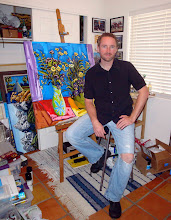
This week I am working on retouching several new paintings, among them a large frieze like piece called "Giants of the Desert II", which is a kind of homage to our local icon, the Saguaro. This one was inspired by some of the beautiful scenes along skyline drive in Tucson. In the new way that I have been working, I finish a painting 90% then set it to dry for a week or two, thereafter the touch ups are much easier and the results are better. Those of you who have seen my work in the flesh know that the paint is extremely thick, and if you continue to work details into thick paint you cut into the texture of it - disturbing the carefully honed shapes that I make in the paint with my palette knife. The process of completing a work is slow, but I have always seen the process as a simple matter of details - it is the result which really matters.
This week I've also been watching a fantastic British documentary called "How Art Shaped the World". In this documentary the commentator spends a great deal of time talking about how research into ancient art has proven that it was hard-wired into the human brain that we should enjoy seeing something other than pure naturalism reproduced. He talks about how there was a brief period in the sculpture of ancient Greece where pure naturalism was achieved, but then it was immediately abandoned and even the human body was subject to exaggerations - commensurate with the Greek ideals of physical beauty and fitness.
I was immediately set to thinking about my work and how it relates to this principle. I've often called my work "controlled exaggerations" or a kind of "synthetic painting." I experienced very early on in my explorations of art a feeling basically identical to the ancient Greeks - that pure reality once achieved told us little - almost nothing. I heard it said that some of the early Impressionist painters had this brought home to them just after the advent of the camera and photography - and that those painters didn't see the slightest point in representing pure visual reality when all you needed to do was take a photo. Save for the fact that the images of the day would be black and white, they would be, pure reality.
So, that is to say, in the age of high resolution digital photography, what is to be done if you are a painter? For me the answer was in a few simple sensations - the first sensation was one of color, but not of normal color - of something higher, brighter, more exaggerated and sensational. And the second main sensation was one of form, mostly brought about by the use of thick paint. By starting at visual reality, but reading it through my own sensations of bright colors and thick paint - I arrived at something I felt I had not seen before. It was closest, not surprisingly, to my mentor Jean-Claude Quilici - but it was not quite that either. There was more brushwork, and perhaps a slightly more abstract color scheme. There was some Van Gogh there also, but there was also a conscious effort to do cleaner, sharper works than the often quickly produced, impulsive Van Goghs. (He could complete 3 paintings in one day. Many of mine take 1 - 2 weeks to complete.) Out of all that emerged a style, something that even I recognized had some good points of distinction.
And when I thought about these things, it occurred to me that I was creating works that would give me more happiness than the best, sharpest digital image - or the best same effort of a realistic painter - I was making something that was a combination of emotion and visual reality. The end product was a hybrid. I realized that the painterly ability to reproduce pure visual reality told me only one thing - that the person has strong stylistic skills. In truth, it tells me little else. That is why some of the best artists, the ones we talk about and the ones that have had a lasting impact on our consciousnesses - they have taken strong artistic abilities and combined them with pure emotion - and thus they have opened many, many other doors of human expression - without having stopped cold behind the door of pure visual reality.
